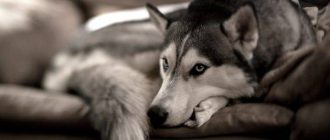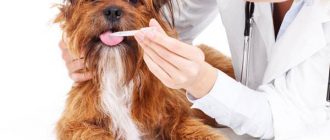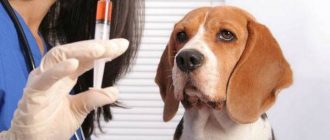Fungus in dogs, or disease dermatophytosis – an ailment infectious etiology requiring veterinary treatment help. No pet is safe from this disease, regardless of the conditions of detention. It is important for owners on time identify the disease based on its symptoms and primary signs.
Content
- 1. Why dogs get sick
- 2. The main signs of fungal infection
- 3. Treatment of fungus in dogs
- 4. Chronic form of fungal infection
- 5. Diagnosis of fungus in dogs and treatment
- 6. Prevention of fungal infections
Why do dogs get sick
Contents
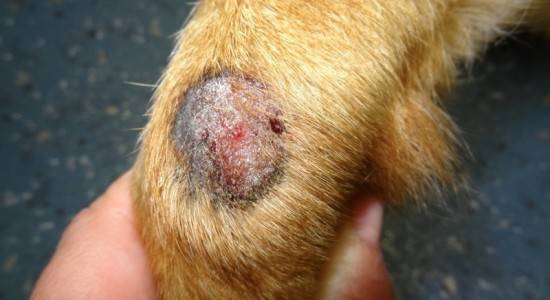
Photo fungus in dogs
There are many types of mushrooms, but only a few are causative agents of dangerous infections in the body of dogs. Infection can occur during contact with another animal, walking on the grass, which are pathogens. Even a dog can become infected which goes to the tray, as often fungi enter the house with shoe owners.
In addition to pathogenic species, there are also opportunistic fungal pathogens. They can always be in the animal’s body, but the dog gets sick only in certain circumstances – weak immunity, hypersensitivity, etc. These types of fungi do not they are contagious, they live on the skin, but they do not cause harm.
At risk for a disease of dermatophysis are young individuals, dogs who have had a disease or surgery interference with problems with the immune system, animals with susceptibility to allergic and skin diseases.

Factors contributing to the development of the disease are unbalanced diet and high humidity. Mushroom growth amplified on the skin that does not receive enough air, covered with fallen wool and a layer of dirt. Fungi also fast breed in dogs, which are very often washed, since this the procedure eliminates sebum and reduces the protection of the skin from external pathogens. In addition, the animal cannot resist ailment after taking immune suppressants the system.
Many other factors contributing to fungal diseases, but even in their absence there is a risk of the animal becoming infected pathogenic fungi.
The main signs of fungal infection
Once on the skin, mushrooms begin to multiply intensively, having a negative effect on the pet’s immune mechanisms. Penetrating deep into the skin, the fungus provokes serious inflammatory processes and diseases in the follicles. Injured skin is fertile environment for the reproduction of various parasites – pathogenic bacteria, protozoa, insects, etc.
Until the origin of the causative agent of this condition is clarified, there is a risk of infection in humans and other animals.
Among the main symptoms of the fungus, the following can be noted:
- the disease begins to develop from one to three spots of a small size;
- the hair begins to fall out from the affected area, in some cases it is as if sheared, leaving a small length;
- formed spots can be the same size for a long time or grow, depending on the type of pathogen and the strength of the protective immunity mechanisms;
- skin at the lesion becomes gray or Blush
- if you look closely, you can find white or grayish coating on the hair bulb;
- the affected area is covered with flakes or flaking flakes, which may fall off the skin or hold tight.
Without timely treatment, baldness increases. The fungus begins to grow into the deep layers, which provokes different kind of complications. In severe stages of the lesion, the dog is completely loses its coat, which for a long time does not is being restored.
Often, the fungus affects the paws of the pet, in this case, inflammation and cracks are observed in the interdigital space and on the pads. The claws can also be affected, then they turn yellow and curved. It hurts a dog to step on its paw, it starts limp.
Dog fungus treatment
Most fungal infections are accompanied by itching, its degree depends on the type of pathogen. In some cases, the dog may comb skin to blood. In this case, experts recommend up to visiting the vet to give an antipruritic drug such as stop itching and use a protective accessory – a collar or blanket, as skin injuries with fungus provoke secondary infection.
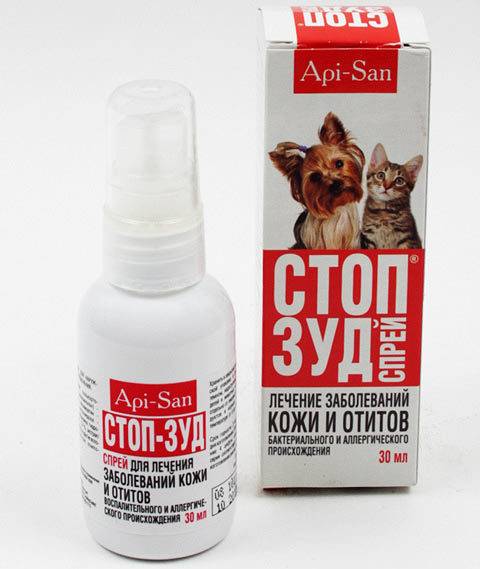
Stop itching for dogs
Emerging wounds should be treated with an external agent, possessing antiseptic effect. From a person’s first-aid kit Miramistin, or must be purchased at a veterinary pharmacy Migstim.
During a visit to a specialist, you should specify in which place the skin was treated with the drug, since the tissue from these areas is not suitable for analysis.
If the fungus affects the paw pads, it is necessary to protect the paws Pet from moisture. During the walk you can use a special safety shoes, after washing the feet, blow dry with a hairdryer. Should not give to the dog to nibble the affected areas of the fungus.
Chronic form of fungal infection
Long-term infection proceeds more calmly. Periodically shedding of hair is observed, the coat becomes dull, often confused and even swimming does not correct the situation.
Owners are not aware of the true causes of the condition, attributing to seasonal molt, vitamin deficiency, a reaction to detergents facilities. Standard measures – a course of vitamins, enhanced nutrition, change of shampoo, etc. do not help.
In some cases, pet sites form small patches without wool – above the auricles, near the nose, on the elbows. Skin the covers may look quite healthy or have a slight gray shade. Similar flaws in long wool are pretty difficult.
Similar processes can occur with insufficient body resistance to this type of fungus, or fungus conditionally pathogenic, not threatening serious the consequences. But at any moment, with related factors, he may start to progress. To find out if a level is skin fungus within the normal range, special skin scrapings are given for analysis.
Dog fungus diagnosis and treatment
First of all, the veterinarian reveals a special coat a lamp under whose rays the fungus begins to glow greenish color. But you should know that almost half of the species of mushrooms do not glow. This method does not provide information about the pathogen, but only confirms its presence.
To prescribe an effective treatment, a full diagnostics to determine the type of fungus, the number of spores, find out the sensitivity to certain drugs.

Specialists recommend donating blood for bacteriology, since often the fungus appears on the background of cocci. In this case treatment consists in eliminating the source.
Quite often, a fungal infection is accompanied by an allergic manifestations, and treatment gives only a temporary result. Help here analysis determining the allergic status of the pet. Identification and allergen and its exclusion will solve the problem with the fungus.
A biochemical blood test will assess the general condition the animal’s body and find out which organs malfunction.
Given all the data obtained, the doctor will be able the first time prescribe adequate treatment. This will help to avoid prolonged useless therapy with a constant change of drugs.
With minor skin lesions, ointments are prescribed – Mycosolone, Yam, Clotrimazole, etc. If the fungus affects large skin areas, apply external antifungal drugs externally not worth it, as this group of drugs is toxic. IN in this case, detergents such as Nizoral are used, Imaverola.
In addition to external medications, veterinarians prescribe medications in tablets or injections. Particularly effective in the treatment of mushrooms Fluconazole is different. Help is also given to the immune system animal in the form of immunostimulants and modulators. Recommended also taking hepatoprotective agents.
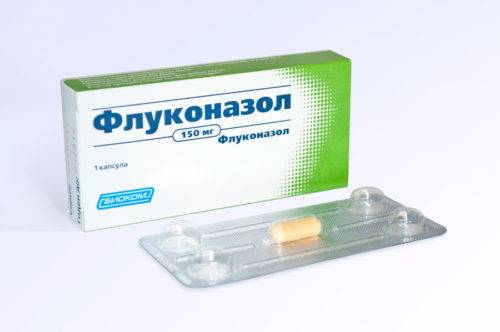
If the detected fungus is contagious, you will need to take additional measures: to carry out processing in gloves, and also, on opportunities to isolate the animal, excluding its contact with children and other pets. But you should visit the dog so that she doesn’t I felt lonely and did not feel stress.
Doctors warn that self-medication can lead to deplorable results. Since some drugs are capable of significantly increase the resistance of the fungus, in which case it will be required treat a dog’s fungus for longer.
Prevention of fungal infections
As noted, the fungal pathogen is difficult to develop in healthy, strong body. Therefore, it’s important to look after the dog, providing good nutrition and appropriate conditions. During walking should avoid habitats of stray animals.
Vaccines against fungal diseases are low effectiveness and in some cases can cause complications, therefore, they are used only in exceptional cases, when the rest therapy is powerless.
But a single way to exclude pathogenic pet infections mushrooms do not exist. In this case, it is important to identify as early as possible. ailment and seek qualified help.

